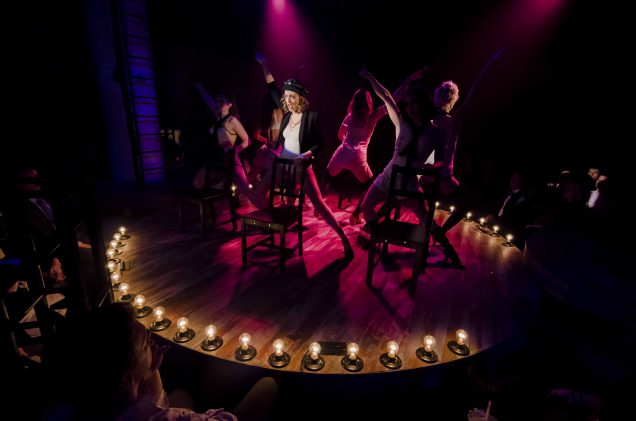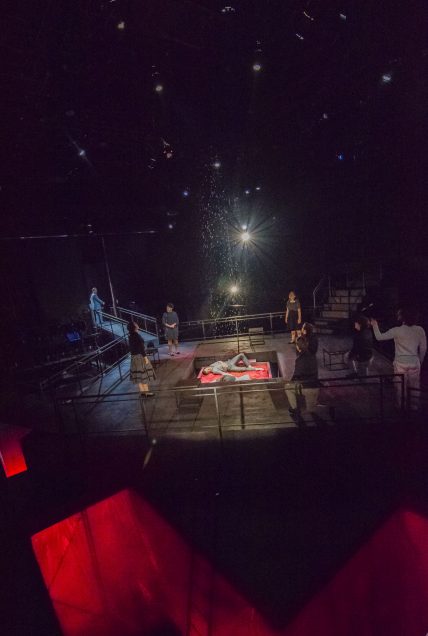Part of a life in the theater is learning how to work within a tight budget. But for students at the School of Theatre in BU’s College of Fine Arts (CFA), there are sometimes ways to make a tight budget a little less restrictive.
“They need to learn how to make a creative response to limitations,” says Jim Petosa, the school’s director and a professor of directing and dramatic criticism. “But we don’t have to teach that by starving them.”
That’s where philanthropy, supplementing the school’s operating budget, comes in. In addition to an endowed fund that supports the annual spring musical, two annual funds—the Theatre Arts Production Fund and the Friends of Theatre Fund—help stave off artistic starvation. The Production Fund is directed toward the specific needs of a given production; the Friends of Theatre Fund helps cover the costs of permanent enhancements to the school’s performance spaces.

From sunrise to late night
While construction of the new Joan & Edgar Booth Theatre was under way, for example, students had no stage to work on, so they had to create productions in several unconventional spaces—and that created unconventional needs. An outdoor staging of Agamemnon near the BU Beach required sound enhancements and special lighting for performances at sunrise, noon, and sunset. And the spring musical, Cabaret, transformed a large studio space in the main CFA building into a nightclub, so that audiences would feel they were actually entering the musical’s Kit Kat Club.
“It took a lot of work to make the space immersive,” Petosa says—work that could not have happened without support from the Production Fund.
Even after the Booth opened, the Friends of Theatre Fund helped address some pressing needs. As students worked on the first production, Rhinoceros, they discovered that they would need some equipment even beyond what the state-of-the-art theater could provide. “Sound and lighting tools,” Petosa explains, “software so students could access the design on their own computers, specialized platforms for different seating configurations—things you can’t know you’ll need until you’re actually in the space.
Making it rain
Those enhancements will become permanent parts of the Booth’s inventory of resources, available for use in future productions. In other cases, though, the Production Fund addresses issues that arise for just one play.

For last season’s Antigone, for example, he and the students decided they needed rain onstage.
“Yes, it was a gorgeous moment,” Petosa says with a smile, “but you need pumps, a drainage system . . .”
In the professional theater, he notes, such a choice is relatively simple: “You want rain? Yeah, we can do that.” But when you’re working with students, he continues, it’s not just a matter of enlisting a designer’s technical skills. First, you have to teach your designer those skills.
“Here, when you decide artistically that you need rain onstage, that becomes a subject of study,” Petosa says. “The student lighting designer has to learn: how do you light rain? You can put something in the water to make it catch the light better—sometimes they used to use a little milk—but it can’t be something that builds up and clogs the pipes. And then you find something that will work when you view it from one angle, but this production is in the round—how do you light rain so you can see it from all four sides?”
This is the sort of challenge, he says, that excites him most as a teacher. “It’s those cases where I don’t know how to do something, and I can say to the student, ‘My experience tells me we could do it this way, your lack of experience tells you we could do it that way’—because sometimes inexperience brings a fresh idea—and together we can figure it out.”
Your giving matters
Giving students the tools and resources to “make stuff happen,” says Petosa, “is really my lifeblood in producing theater here.” And it’s the School of Theatre’s annual funds that make it possible.
“Without those two funds,” Petosa says, “I don’t know how I could run the school.”
Not yet a donor? Give now and receive email updates on the impact donors have throughout the year. Visit our Donor Stories web page to read more about the committed donors at Boston University.
